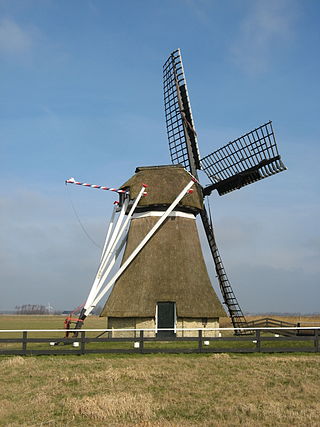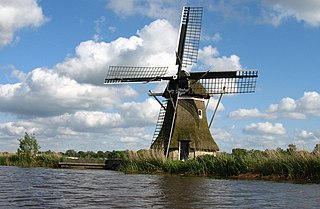
De Olifant is a smock mill in Burdaard, Friesland, Netherlands which has been restored to working order. The mill is listed as a Rijksmonument, number 35673.

De Volharding is a smock mill in Jislum, Friesland, Netherlands which was built in 1872. The mill has been restored to working order and designated as being held in reserve in times of emergency. It is listed as a Rijksmonument, number 15632.

De Marsummermolen English: The mill of Marssum is a smock mill in Marsum, Friesland, Netherlands which was built in 1903. The mill has been restored to working order and is used as a training mill. It is listed as a Rijksmonument, number 28624.

De Kievit is a smock mill in Menaam, Friesland, Netherlands which was built in 1802. The mill has been restored to working order. It is listed as a Rijksmonument.

De Rentmeester is a smock mill in Menaam, Friesland, Netherlands which was built in Dronryp in 1857 and moved to a new site at Menaldum in 1982, replacing a mill that had burnt down. The mill has been restored to working order. It is listed as a Rijksmonument.

De Tjongermolen is a smock mill in Mildam, Friesland, Netherlands which was built in 1918, replacing a mill that had blown down and rebuilt on a new site in 1983. The mill has been restored to working order. It is listed as a Rijksmonument.

't Zwaantje is a smock mill in Nijemirdum, Friesland, Netherlands which was built in 1878. The mill has been restored to working order. It is listed as a Rijksmonument.

De Balkendsterpoldermolen is a smock mill in Alde Leie, Friesland, Netherlands which was built in 1844. The mill has been restored to working order and is designated as being held in reserve. It is listed as a Rijksmonument.

De Hoop is a smock mill in Readtsjerk, Friesland, Netherlands which was built in 1911. The mill has been restored to working order. It is listed as a Rijksmonument.

Ypey Mole is a smock mill in Ryptsjerk, Friesland, Netherlands which was built in 1911. The mill has been restored to working order. It is listed as a Rijksmonument.

De Schalsumermolen is a smock mill in Schalsum, Friesland, Netherlands which was built in 1801. The mill has been restored to working order. Used as a training mill, it is listed as a Rijksmonument.

De Skarrenmolen is a smock mill in Scharsterbrug, Friesland, Netherlands which was built in 1888. The mill has been restored to working order. It is listed as a Rijksmonument.

De Deels, Douwemûne, or Grevensmolen is a smock mill in Vegelinsoord, Friesland, Netherlands which was built in 1859 and has been restored to working order. It is listed as a Rijksmonument.

De Hempenserpoldermolen is a smock mill in Wergea, Friesland, Netherlands which was built in 1863 and has been restored to working order. It is listed as a Rijksmonument.

De Beintemapoldermolen is a smock mill in Westergeest, Friesland, Netherlands which was built in 1870 and has been restored to working order. It is listed as a Rijksmonument.

Langwert is a smock mill in Winsum, Friesland, Netherlands which was built in 1979 and is under restoration. It is listed as a Rijksmonument.

De Pankoekstermolen is a smock mill in Witmarsum, Friesland, Netherlands which was built in 1900. It has been restored to working order and is designated as being in reserve. It is listed as a Rijksmonument.

De Gooyer is a smock mill in Wolvega, Friesland, Netherlands which was built in 1916. It has been restored to working order. It is listed as a Rijksmonument.

De Snip is a smock mill in Workum, Friesland, Netherlands. It has been restored to working order. Designated as being held in reserve, it is listed as a Rijksmonument.

Ybema's molen is a smock mill in Workum, Friesland, Netherlands. It has been restored to working order. Designated as being held in reserve, it is listed as a Rijksmonument.





















